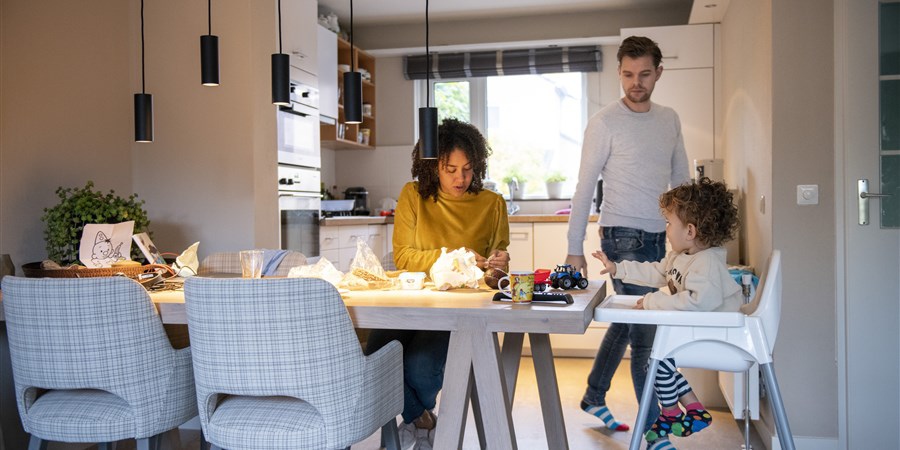Fewer 30-year-olds have settled down

The number of thirty-year-olds who own their own home has fallen the most: from 62 percent in 2011 to 51 percent in 2021. The number of thirty-year-olds who were parents fell from 39 percent to 35 percent.
| Categorie | 2021 (%) | 2011 (%) |
|---|---|---|
| Living independently | 88.8 | 91.4 |
| Cohabiting with partner | 62.1 | 66.4 |
| Permanent employment | 56.3 | 58.7 |
| Home owner | 51.1 | 62.0 |
| Parent | 34.8 | 39.1 |
Thirty-year-olds in permanent employment are the most likely to have settled down
Thirty-year-olds in permanent employment are more likely to live independently or with a partner than those in flexible employment or with no job at all. They are also more likely to have a child and/or own their own home.
Thirty-year-olds not in employment or in education were less likely to have settled down in 2021 than a decade earlier. In this group, the proportion who owned their own home decreased from 31 percent to 20 percent. Also, fewer were cohabiting with a partner (from 46 percent to 37 percent) and fewer had a child (from 42 percent to 35 percent).
| 2021 (%) | 2011 (%) | |
|---|---|---|
| Permanent | ||
| Living independently | 92 | 93.6 |
| Cohabiting with partner | 69.5 | 72.1 |
| Has child | 36.4 | 40.7 |
| Home owner | 63 | 72.1 |
| Flexible | ||
| Living independently | 87.1 | 90.8 |
| Cohabiting with partner | 60.4 | 64.2 |
| Has child | 31.9 | 35.1 |
| Home owner | 43.4 | 55.7 |
| In education/No work | ||
| Living independently | 80.1 | 83.3 |
| Cohabiting with partner | 37 | 46.1 |
| Has child | 35.1 | 42.9 |
| Home owner | 19.9 | 30.5 |
Thirty-year-olds with family less likely to buy home
Thirty-year-olds living with a partner and child are the most likely to own their own home, but the share varies by educational and employment status. Thirty-year-olds not in employment and without a degree from college or university are the least likely to own their own home (45 percent in 2021).
The proportion who owned their own home decreased across all groups. The largest decrease was among thirty-year-olds with a degree from college or university but without a job (from 75 percent in 2011 to 61 percent 10 years later). In 2011, they were more likely to own their home than those in flexible employment without a college or university degree, but in 2021 they were less likely to do so.
| Categorie | 2021 (%) | 2011 (%) |
|---|---|---|
| No degree from college/university | ||
| Permanent employment | 81.9 | 83.6 |
| Flexible employment | 68.7 | 71.0 |
| In education/No work | 44.7 | 50.2 |
| Degree from college/university | ||
| Permanent employment | 89.5 | 92.8 |
| Flexible employment | 80.7 | 85.7 |
| In education/No work | 61.2 | 75.2 |
Sharpest fall in homeownership among those living alone without employment
Thirty-year-olds living alone are the least likely to own their own home. This share fell relatively sharply between 2011 and 2021, especially among those not in employment and without a college or university degree. Between 2011 and 2021, the share who own their own home in this group nearly halved (from 16 percent to 9 percent).
Among thirty-year-olds living alone who are in permanent or flexible employment, homeownership decreased the most sharply among those with a college or university degree. This share fell from 57 percent in 2011 to 44 percent in 2021 among those in permanent employment, and from 36 percent to 23 percent for those in flexible employment.
| Jaartal | 2021 (%) | 2011 (%) |
|---|---|---|
| No degree from college/university | ||
| Permanent employment | 41.8 | 47.6 |
| Flexible employment | 22.6 | 33.3 |
| In education/No work | 8.5 | 15.8 |
| Degree from college/university | ||
| Permanent employment | 43.6 | 56.8 |
| Flexible employment | 22.7 | 36.1 |
| In education/No work | 17.0 | 22.5 |